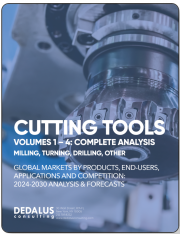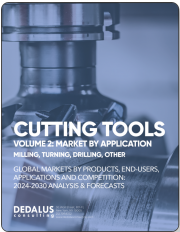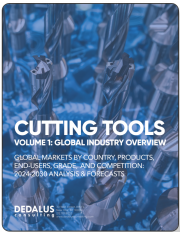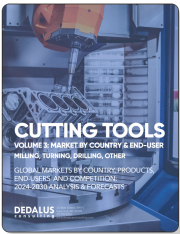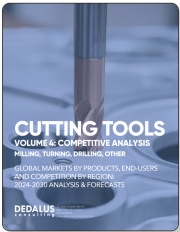
|
시장보고서
상품코드
1611365
세계의 톱질 및 절단 공구 시장 : 제품, 용도, 유통 채널별 예측(2025-2030년)Sawing & Cutting Tools Market by Product (Band Saw, Bow Saw, Chisels), Application (Automotive, Construction, Electronics), Distribution Channel - Global Forecast 2025-2030 |
||||||
톱질 및 절단 공구 시장은 2023년에 21억 4,000만 달러로 평가되었고, 2024년에는 23억 3,000만 달러에 달할 것으로 예측되며, 복합 연간 성장률(CAGR) 8.51%로 성장하여, 2030년에는 37억 9,000만 달러에 달할 것으로 예상됩니다.
톱질 및 절단 공구 시장은 건설, 제조, 자동차 및 항공우주를 포함한 다양한 산업에서 사용되는 핸드 툴과 전동 공구를 광범위하게 다룹니다. 이 공구는 목재, 금속, 콘크리트와 같은 재료의 정밀 절단, 성형 및 마무리에 필수적입니다. 그 필요성은 소규모 DIY 프로젝트부터 대규모 산업 생산 라인에 이르기까지 다양한 용도로 사용되고 있다는 점에서 분명합니다. 이 시장은 전문 업체와 일반 소비자 모두를 지원하며 최종 용도는 주택, 상업 및 산업 부문에 걸쳐 있습니다. 이 시장에 영향을 미치는 주요 성장 요인으로는 효율성과 정밀도를 높이는 스마트 센서 및 공구 자동화와 같은 기술의 발전이 포함됩니다. 또한 환경 규제와 휴대용 무선 솔루션 수요를 배경으로 배터리 구동 공구로의 이동이 진행되고 있습니다. 전자상거래와 디지털 구매 플랫폼의 상승은 시장 침투와 성장의 길을 더욱 열어줍니다. 그러나 시장의 성장에는 원재료 가격의 변동과 고도의 기계의 높은 유지 보수 비용과 같은 과제가 있습니다. 게다가, 특히 세계 사건과 관련된 공급망의 혼란은 큰 위험이 됩니다. 호기는 재활용 가능한 재료로 만든 공구와 에너지 소비를 줄이기 위해 설계된 공구 등 지속가능성에 초점을 맞춘 혁신적인 제품 개발에 있습니다. 예지 보전 및 사용자 맞춤화를 위한 데이터 분석의 활용도 잠재적인 성장 길을 제공합니다. 기업은 가볍고 내구성있는 소재와 자동화 기능을 탐구하는 R&D에 투자하는 것이 좋습니다. 경쟁은 치열하지만 틈새 시장과 맞춤형 솔루션에 집중하여 경쟁력을 높일 수 있습니다. 시장의 특성은 역동적이며 전통적인 장인 기술과 현대 기술이 융합되어 있기 때문에 기업은 소비자와 산업계 수요 변화에 민첩하게 대응해야합니다.
| 주요 시장 통계 | |
|---|---|
| 기준년(2023) | 21억 4,000만 달러 |
| 추정년(2024) | 23억 3,000만 달러 |
| 예측년(2030) | 37억 9,000만 달러 |
| 복합 연간 성장률(CAGR)(%) | 8.51% |
시장 역학 : 급속히 진화하는 톱질 및 절단 공구 시장의 주요 시장 인사이트를 공개
톱질 및 절단 공구 시장은 수요 및 공급의 역동적인 상호작용에 의해 변모를 이루고 있습니다. 이러한 시장 역학의 진화를 이해함으로써 기업은 충분한 정보를 바탕으로 투자결정, 전략적 의사결정, 새로운 비즈니스 기회를 획득할 수 있습니다. 이러한 동향을 종합적으로 파악함으로써 기업은 정치적, 지리적, 기술적, 사회적, 경제적 영역에 걸친 다양한 리스크를 경감할 수 있을 뿐만 아니라, 소비자 행동과 그것이 제조 비용 또는 구매 동향에 미치는 영향을보다 명확하게 이해할 수 있습니다.
- 시장 성장 촉진요인
- 상업 및 주택 건설 활동 증가
- DIY 프로젝트에 있어서의 휴대용 톱질 및 절단 공구의 인기
- 각국의 인더스트리 4.0 정책 도입
- 시장 성장 억제요인
- 제재, 절단 공구의 고비용
- 시장 기회
- 톱질 및 절단 공구 기술의 진보
- 분석 방법에 의한 톱질 및 절단 공구의 최적화
- 시장의 과제
- 톱질 및 절단 공구의 마모와 고장의 가능성
Porter's Five Forces : 톱질 및 절단 공구 시장을 탐색하는 전략 공구
Porter's Five Forces Framework는 톱질 및 절단 공구 시장 경쟁 구도를 이해하는 중요한 공구입니다. Porter's Five Forces Framework는 기업의 경쟁력을 평가하고 전략적 기회를 탐구하는 명확한 기술을 제공합니다. 이 프레임워크는 기업이 시장 내 세력도를 평가하고 신규 사업의 수익성을 판단하는 데 도움이 됩니다. 이러한 인사이트을 통해 기업은 자사의 강점을 활용하고 약점을 해결하고 잠재적인 과제를 피함으로써 보다 강인한 시장에서의 포지셔닝을 확보할 수 있습니다.
PESTLE 분석 : 톱질 및 절단 공구 시장에서 외부로부터의 영향 파악
외부 거시 환경 요인은 톱질 및 절단 공구 시장의 성과 역학을 형성하는 데 매우 중요한 역할을 합니다. 정치적, 경제적, 사회적, 기술적, 법적, 환경적 요인 분석은 이러한 영향을 탐색하는 데 필요한 정보를 제공합니다. PESTLE 요인을 조사함으로써 기업은 잠재적인 위험과 기회를 더 잘 이해할 수 있습니다. 이 분석을 통해 기업은 규제, 소비자 선호, 경제 동향의 변화를 예측하고 앞으로 예상되는 적극적인 의사 결정을 할 준비가 가능합니다.
시장 점유율 분석 톱질 및 절단 공구 시장에서경쟁 구도 파악
톱질 및 절단 공구 시장의 상세한 시장 점유율 분석을 통해 공급업체의 성과를 종합적으로 평가할 수 있습니다. 기업은 수익, 고객 기반, 성장률 등 주요 지표를 비교하여 경쟁 포지셔닝을 밝힐 수 있습니다. 이 분석을 통해 시장 집중, 단편화, 통합 동향을 밝혀내고 벤더들은 경쟁이 치열해지는 가운데 자사의 지위를 높이는 전략적 의사 결정을 내리는 데 필요한 지식을 얻을 수 있습니다.
FPNV 포지셔닝, 매트릭스 톱 및 절삭 공구 시장에서 공급업체의 성능 평가
FPNV 포지셔닝 매트릭스는 톱질 및 절단 공구 시장에서 벤더를 평가하는 중요한 공구입니다. 이 행렬을 통해 비즈니스 조직은 공급업체의 비즈니스 전략과 제품 만족도를 기준으로 평가하여 목표에 맞는 충분한 정보를 바탕으로 의사 결정을 내릴 수 있습니다. 네 가지 사분면을 통해 공급업체를 명확하고 정확하게 세분화하여 전략 목표에 가장 적합한 파트너 및 솔루션을 파악할 수 있습니다..
전략 분석과 추천 톱질 및 절단 공구 시장에서의 성공에의 길을 그립니다.
톱질 및 절단 공구 시장의 전략 분석은 시장에서의 프레즌스 강화를 목표로 하는 기업에 필수적입니다. 이 접근법을 통해 경쟁 구도에서 과제를 극복하고 새로운 비즈니스 기회를 활용하여 장기적인 성공을 거둘 수 있는 시스템을 구축할 수 있습니다.
이 보고서는 주요 관심 분야를 포괄하는 시장의 종합적인 분석을 제공합니다.
1. 시장 침투 : 현재 시장 환경의 상세한 검토, 주요 기업의 광범위한 데이터, 시장 도달범위 및 전반적인 영향력 평가.
2. 시장 개척도 : 신흥 시장의 성장 기회를 파악하고 기존 분야의 확장 가능성을 평가하며 미래 성장을 위한 전략적 로드맵을 제공합니다.
3. 시장 다양화 : 최근 제품 시장, 미개척 지역, 업계의 주요 진보, 시장을 형성하는 전략적 투자를 분석합니다.
4. 경쟁 평가 및 정보 : 경쟁 구도를 철저히 분석하여 시장 점유율, 사업 전략, 제품 포트폴리오, 인증, 규제 당국 승인, 특허 동향, 주요 기업의 기술 진보 등을 검증합니다.
5. 제품 개발 및 혁신 : 미래 시장 성장을 가속할 것으로 예상되는 최첨단 기술, R&D 활동, 제품 혁신을 강조합니다.
또한 이해관계자가 충분한 정보를 얻고 의사결정을 할 수 있도록 중요한 질문에 대답하고 있습니다.
1. 현재 시장 규모와 향후 성장 예측은?
2. 최고의 투자 기회를 제공하는 제품, 부문 및 지역은 어디입니까?
3. 시장을 형성하는 주요 기술 동향과 규제의 영향은?
4. 주요 벤더의 시장 점유율과 경쟁 포지션은?
5. 벤더 시장 진입, 철수 전략의 원동력이 되는 수익원과 전략적 기회는 무엇인가?
목차
제1장 서문
제2장 조사 방법
제3장 주요 요약
제4장 시장 개요
제5장 시장 인사이트
- 시장 역학
- 성장 촉진요인
- 상업, 주택 건설 활동 증가
- DIY 프로젝트에 있어서의 휴대용 톱질 및 절단 공구의 인기
- 경제에서의 인더스트리 4.0 정책의 소개
- 억제요인
- 톱이나 절단 공구의 비용이 높다
- 기회
- 톱 절단 및 절삭 공구 기술의 진보
- 분석 방법에 의한 톱질 및 절단 공구의 최적화
- 과제
- 톱질 및 절단 공구의 소모나 고장의 가능성
- 성장 촉진요인
- 시장 세분화 분석
- Porter's Five Forces 분석
- PESTEL 분석
- 정치적
- 경제
- 사교
- 기술적
- 법률상
- 환경
제6장 톱질 및 절단 공구 시장 : 제품별
- 밴드톱
- 활톱
- 벼룩
- 코핑소
- 크로스컷 톱
- 활톱
- 일본 톱
- 지그소 퍼즐
- 전정톱
- 립컷 톱
- 라우터
- 테이블톱
제7장 톱질 및 절단 공구 시장 : 용도별
- 자동차
- 공사
- 일렉트로닉스
- 해양
제8장 톱질 및 절단 공구 시장 : 유통 채널별
- 오프라인
- 온라인
제9장 아메리카의 톱질 및 절단 공구 시장
- 아르헨티나
- 브라질
- 캐나다
- 멕시코
- 미국
제10장 아시아태평양의 톱질 및 절단 공구 시장
- 호주
- 중국
- 인도
- 인도네시아
- 일본
- 말레이시아
- 필리핀
- 싱가포르
- 한국
- 대만
- 태국
- 베트남
제11장 유럽, 중동 및 아프리카의 톱질 및 절단 공구 시장
- 덴마크
- 이집트
- 핀란드
- 프랑스
- 독일
- 이스라엘
- 이탈리아
- 네덜란드
- 나이지리아
- 노르웨이
- 폴란드
- 카타르
- 러시아
- 사우디아라비아
- 남아프리카
- 스페인
- 스웨덴
- 스위스
- 터키
- 아랍에미리트(UAE)
- 영국
제12장 경쟁 구도
- 시장 점유율 분석(2023년)
- FPNV 포지셔닝 매트릭스(2023년)
- 경쟁 시나리오 분석
- 전략 분석과 제안
기업 목록
- Alfa Max Tools
- Apex Tool Group
- Atlas Copco AB
- BLACK DECKER
- Hilti Corporation
- Husqvarna Group
- Ingersoll-Rand
- Klein Tools, Inc.
- KPT Industries Ltd.
- KYOCERA Corporation
- Magicut Tools Ltd.
- Misumi India Pvt. Ltd.
- Robert Bosch GmbH
- Seco Tools India(P) Ltd.
- Snap-on Incorporated
- Sumitomo Electric Industries, Ltd.
The Sawing & Cutting Tools Market was valued at USD 2.14 billion in 2023, expected to reach USD 2.33 billion in 2024, and is projected to grow at a CAGR of 8.51%, to USD 3.79 billion by 2030.
The market for sawing and cutting tools encompasses a broad range of hand and power tools used across various industries including construction, manufacturing, automotive, and aerospace. These tools are essential for precision cutting, shaping, and finishing materials such as wood, metal, and concrete. Their necessity is underscored by the diverse applications they serve, from small-scale DIY projects to large industrial production lines. The market caters to both professional tradespeople and general consumers, with end-use spanning residential, commercial, and industrial sectors. Key growth factors influencing this market include advancements in technology, such as the integration of smart sensors and automation in tools, which enhance efficiency and precision. There's also an increasing shift towards battery-powered tools, driven by environmental regulations and demand for portable, cordless solutions. The rise of e-commerce and digital purchasing platforms further opens avenues for market penetration and growth. However, market growth is challenged by factors such as fluctuating raw material prices and the high maintenance costs of advanced machinery. Additionally, supply chain disruptions, especially in the wake of global events, pose significant risks. Opportunities lie in the development of innovative products focused on sustainability, such as tools made from recyclable materials or those designed to reduce energy consumption. Leveraging data analytics for predictive maintenance and user customization also offers potential growth avenues. Companies are encouraged to invest in research and development to explore lightweight, durable materials and automation features. While competition is intense, focusing on niche markets and custom solutions can provide a competitive edge. The nature of the market is dynamic, blending traditional craftsmanship with modern technology, requiring businesses to stay agile and responsive to shifting consumer and industrial demands.
| KEY MARKET STATISTICS | |
|---|---|
| Base Year [2023] | USD 2.14 billion |
| Estimated Year [2024] | USD 2.33 billion |
| Forecast Year [2030] | USD 3.79 billion |
| CAGR (%) | 8.51% |
Market Dynamics: Unveiling Key Market Insights in the Rapidly Evolving Sawing & Cutting Tools Market
The Sawing & Cutting Tools Market is undergoing transformative changes driven by a dynamic interplay of supply and demand factors. Understanding these evolving market dynamics prepares business organizations to make informed investment decisions, refine strategic decisions, and seize new opportunities. By gaining a comprehensive view of these trends, business organizations can mitigate various risks across political, geographic, technical, social, and economic domains while also gaining a clearer understanding of consumer behavior and its impact on manufacturing costs and purchasing trends.
- Market Drivers
- Increasing commercial and residential construction activities
- Popularity of portable sawing & cutting tools in DIY projects
- Introduction of Industry 4.0 policies in economies
- Market Restraints
- High costs of sawing and cutting tools
- Market Opportunities
- Advancements in sawing & cutting tool technologies
- Optimization of sawing & cutting tools through analytical methods
- Market Challenges
- Possibility of wear & tear and failures of sawing & cutting tools
Porter's Five Forces: A Strategic Tool for Navigating the Sawing & Cutting Tools Market
Porter's five forces framework is a critical tool for understanding the competitive landscape of the Sawing & Cutting Tools Market. It offers business organizations with a clear methodology for evaluating their competitive positioning and exploring strategic opportunities. This framework helps businesses assess the power dynamics within the market and determine the profitability of new ventures. With these insights, business organizations can leverage their strengths, address weaknesses, and avoid potential challenges, ensuring a more resilient market positioning.
PESTLE Analysis: Navigating External Influences in the Sawing & Cutting Tools Market
External macro-environmental factors play a pivotal role in shaping the performance dynamics of the Sawing & Cutting Tools Market. Political, Economic, Social, Technological, Legal, and Environmental factors analysis provides the necessary information to navigate these influences. By examining PESTLE factors, businesses can better understand potential risks and opportunities. This analysis enables business organizations to anticipate changes in regulations, consumer preferences, and economic trends, ensuring they are prepared to make proactive, forward-thinking decisions.
Market Share Analysis: Understanding the Competitive Landscape in the Sawing & Cutting Tools Market
A detailed market share analysis in the Sawing & Cutting Tools Market provides a comprehensive assessment of vendors' performance. Companies can identify their competitive positioning by comparing key metrics, including revenue, customer base, and growth rates. This analysis highlights market concentration, fragmentation, and trends in consolidation, offering vendors the insights required to make strategic decisions that enhance their position in an increasingly competitive landscape.
FPNV Positioning Matrix: Evaluating Vendors' Performance in the Sawing & Cutting Tools Market
The Forefront, Pathfinder, Niche, Vital (FPNV) Positioning Matrix is a critical tool for evaluating vendors within the Sawing & Cutting Tools Market. This matrix enables business organizations to make well-informed decisions that align with their goals by assessing vendors based on their business strategy and product satisfaction. The four quadrants provide a clear and precise segmentation of vendors, helping users identify the right partners and solutions that best fit their strategic objectives.
Strategy Analysis & Recommendation: Charting a Path to Success in the Sawing & Cutting Tools Market
A strategic analysis of the Sawing & Cutting Tools Market is essential for businesses looking to strengthen their global market presence. By reviewing key resources, capabilities, and performance indicators, business organizations can identify growth opportunities and work toward improvement. This approach helps businesses navigate challenges in the competitive landscape and ensures they are well-positioned to capitalize on newer opportunities and drive long-term success.
Key Company Profiles
The report delves into recent significant developments in the Sawing & Cutting Tools Market, highlighting leading vendors and their innovative profiles. These include Alfa Max Tools, Apex Tool Group, Atlas Copco AB, BLACK+DECKER, Hilti Corporation, Husqvarna Group, Ingersoll-Rand, Klein Tools, Inc., KPT Industries Ltd., KYOCERA Corporation, Magicut Tools Ltd., Misumi India Pvt. Ltd., Robert Bosch GmbH, Seco Tools India (P) Ltd., Snap-on Incorporated, and Sumitomo Electric Industries, Ltd..
Market Segmentation & Coverage
This research report categorizes the Sawing & Cutting Tools Market to forecast the revenues and analyze trends in each of the following sub-markets:
- Based on Product, market is studied across Band Saw, Bow Saw, Chisels, Coping Saws, Crosscut Saw, Hacksaws, Japanese Saw, Jigsaw, Pruning Saw, Rip Cut Saw, Router, and Table Saw.
- Based on Application, market is studied across Automotive, Construction, Electronics, and Marine.
- Based on Distribution Channel, market is studied across Offline and Online.
- Based on Region, market is studied across Americas, Asia-Pacific, and Europe, Middle East & Africa. The Americas is further studied across Argentina, Brazil, Canada, Mexico, and United States. The United States is further studied across California, Florida, Illinois, New York, Ohio, Pennsylvania, and Texas. The Asia-Pacific is further studied across Australia, China, India, Indonesia, Japan, Malaysia, Philippines, Singapore, South Korea, Taiwan, Thailand, and Vietnam. The Europe, Middle East & Africa is further studied across Denmark, Egypt, Finland, France, Germany, Israel, Italy, Netherlands, Nigeria, Norway, Poland, Qatar, Russia, Saudi Arabia, South Africa, Spain, Sweden, Switzerland, Turkey, United Arab Emirates, and United Kingdom.
The report offers a comprehensive analysis of the market, covering key focus areas:
1. Market Penetration: A detailed review of the current market environment, including extensive data from top industry players, evaluating their market reach and overall influence.
2. Market Development: Identifies growth opportunities in emerging markets and assesses expansion potential in established sectors, providing a strategic roadmap for future growth.
3. Market Diversification: Analyzes recent product launches, untapped geographic regions, major industry advancements, and strategic investments reshaping the market.
4. Competitive Assessment & Intelligence: Provides a thorough analysis of the competitive landscape, examining market share, business strategies, product portfolios, certifications, regulatory approvals, patent trends, and technological advancements of key players.
5. Product Development & Innovation: Highlights cutting-edge technologies, R&D activities, and product innovations expected to drive future market growth.
The report also answers critical questions to aid stakeholders in making informed decisions:
1. What is the current market size, and what is the forecasted growth?
2. Which products, segments, and regions offer the best investment opportunities?
3. What are the key technology trends and regulatory influences shaping the market?
4. How do leading vendors rank in terms of market share and competitive positioning?
5. What revenue sources and strategic opportunities drive vendors' market entry or exit strategies?
Table of Contents
1. Preface
- 1.1. Objectives of the Study
- 1.2. Market Segmentation & Coverage
- 1.3. Years Considered for the Study
- 1.4. Currency & Pricing
- 1.5. Language
- 1.6. Stakeholders
2. Research Methodology
- 2.1. Define: Research Objective
- 2.2. Determine: Research Design
- 2.3. Prepare: Research Instrument
- 2.4. Collect: Data Source
- 2.5. Analyze: Data Interpretation
- 2.6. Formulate: Data Verification
- 2.7. Publish: Research Report
- 2.8. Repeat: Report Update
3. Executive Summary
4. Market Overview
5. Market Insights
- 5.1. Market Dynamics
- 5.1.1. Drivers
- 5.1.1.1. Increasing commercial and residential construction activities
- 5.1.1.2. Popularity of portable sawing & cutting tools in DIY projects
- 5.1.1.3. Introduction of Industry 4.0 policies in economies
- 5.1.2. Restraints
- 5.1.2.1. High costs of sawing and cutting tools
- 5.1.3. Opportunities
- 5.1.3.1. Advancements in sawing & cutting tool technologies
- 5.1.3.2. Optimization of sawing & cutting tools through analytical methods
- 5.1.4. Challenges
- 5.1.4.1. Possibility of wear & tear and failures of sawing & cutting tools
- 5.1.1. Drivers
- 5.2. Market Segmentation Analysis
- 5.3. Porter's Five Forces Analysis
- 5.3.1. Threat of New Entrants
- 5.3.2. Threat of Substitutes
- 5.3.3. Bargaining Power of Customers
- 5.3.4. Bargaining Power of Suppliers
- 5.3.5. Industry Rivalry
- 5.4. PESTLE Analysis
- 5.4.1. Political
- 5.4.2. Economic
- 5.4.3. Social
- 5.4.4. Technological
- 5.4.5. Legal
- 5.4.6. Environmental
6. Sawing & Cutting Tools Market, by Product
- 6.1. Introduction
- 6.2. Band Saw
- 6.3. Bow Saw
- 6.4. Chisels
- 6.5. Coping Saws
- 6.6. Crosscut Saw
- 6.7. Hacksaws
- 6.8. Japanese Saw
- 6.9. Jigsaw
- 6.10. Pruning Saw
- 6.11. Rip Cut Saw
- 6.12. Router
- 6.13. Table Saw
7. Sawing & Cutting Tools Market, by Application
- 7.1. Introduction
- 7.2. Automotive
- 7.3. Construction
- 7.4. Electronics
- 7.5. Marine
8. Sawing & Cutting Tools Market, by Distribution Channel
- 8.1. Introduction
- 8.2. Offline
- 8.3. Online
9. Americas Sawing & Cutting Tools Market
- 9.1. Introduction
- 9.2. Argentina
- 9.3. Brazil
- 9.4. Canada
- 9.5. Mexico
- 9.6. United States
10. Asia-Pacific Sawing & Cutting Tools Market
- 10.1. Introduction
- 10.2. Australia
- 10.3. China
- 10.4. India
- 10.5. Indonesia
- 10.6. Japan
- 10.7. Malaysia
- 10.8. Philippines
- 10.9. Singapore
- 10.10. South Korea
- 10.11. Taiwan
- 10.12. Thailand
- 10.13. Vietnam
11. Europe, Middle East & Africa Sawing & Cutting Tools Market
- 11.1. Introduction
- 11.2. Denmark
- 11.3. Egypt
- 11.4. Finland
- 11.5. France
- 11.6. Germany
- 11.7. Israel
- 11.8. Italy
- 11.9. Netherlands
- 11.10. Nigeria
- 11.11. Norway
- 11.12. Poland
- 11.13. Qatar
- 11.14. Russia
- 11.15. Saudi Arabia
- 11.16. South Africa
- 11.17. Spain
- 11.18. Sweden
- 11.19. Switzerland
- 11.20. Turkey
- 11.21. United Arab Emirates
- 11.22. United Kingdom
12. Competitive Landscape
- 12.1. Market Share Analysis, 2023
- 12.2. FPNV Positioning Matrix, 2023
- 12.3. Competitive Scenario Analysis
- 12.4. Strategy Analysis & Recommendation
Companies Mentioned
- 1. Alfa Max Tools
- 2. Apex Tool Group
- 3. Atlas Copco AB
- 4. BLACK+DECKER
- 5. Hilti Corporation
- 6. Husqvarna Group
- 7. Ingersoll-Rand
- 8. Klein Tools, Inc.
- 9. KPT Industries Ltd.
- 10. KYOCERA Corporation
- 11. Magicut Tools Ltd.
- 12. Misumi India Pvt. Ltd.
- 13. Robert Bosch GmbH
- 14. Seco Tools India (P) Ltd.
- 15. Snap-on Incorporated
- 16. Sumitomo Electric Industries, Ltd.








